#navratri special story
Explore tagged Tumblr posts
Text
9 Vibrant Navratri Outfit Ideas To Celebrate Each Night In Style
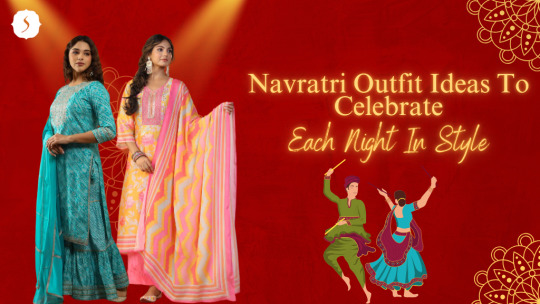
Navratri, one of the prominent festivals in India is a time of joy, dance, and colourful celebrations. Each of the nine nights is marked by a specific colour, offering a wonderful excuse to showcase your style.
Let’s explore some outfits that will help you look your best each day of the festival.
Day 1: Yellow
Kick off the festival with a burst of sunshine! The Nayab Mishti Yellow Floral Angrakha Kurta Set is a perfect choice. This delightful outfit features intricate floral patterns that are both cheerful and elegant. Paired with a flowing dupatta, it gives a lovely traditional touch while keeping you comfortable for all the festivities.
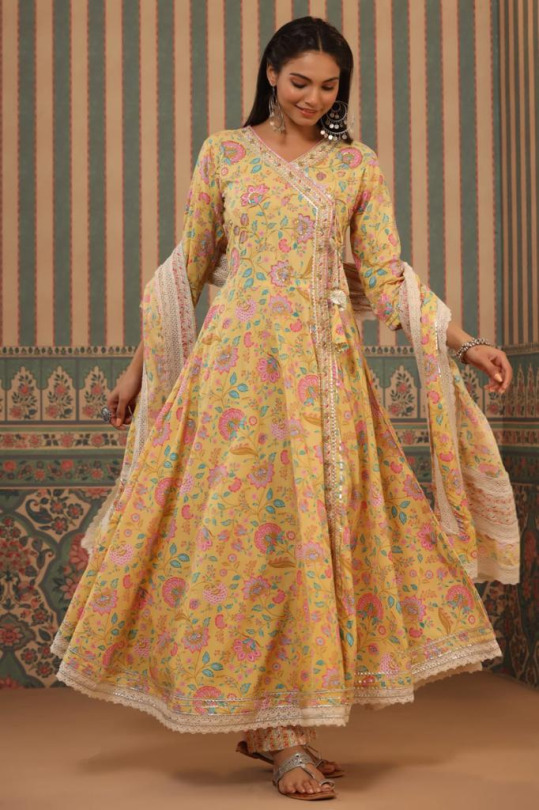
Day 2: Green
On the second day, opt for a refreshing vibe with the Chandani Heena Chanderi Hand Block Printed Dupatta. This dupatta, with its artistic hand-block prints, can elevate any outfit. You can wear it with a simple kurta or even a contemporary dress. The green hues symbolize growth and harmony, perfect for the spirit of the festival.

Day 3: Grey
For the third night, consider the sophisticated Farzeen Bridavan Phool Pleated Dress. The elegant grey fabric adorned with delicate floral prints offers a subtle yet chic look. With its pleated design, this dress enables easy of movement, making it ideal for dancing the night away while staying stylish.
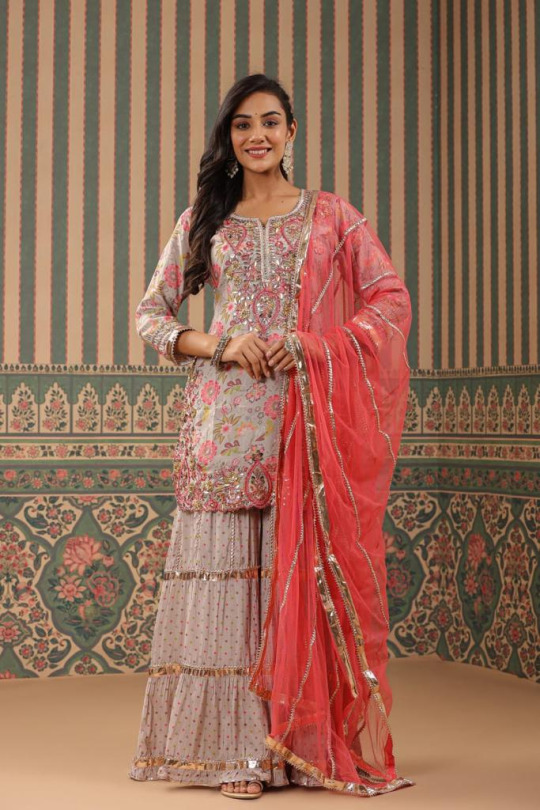
Day 4: Orange
Day four calls for vibrancy! The Faiza Bulbul Wajida Kurta and Palazzo Set in a striking orange is just the thing. This is a kurta that stands out with its beautiful peony patterns and offers a comfortable fit. It’s perfect for the lively garba nights, adding a pop of colour to your celebration.

Day 5: White
On the fifth day, opt for purity with the Gulnaaz Sherjeena White Cotton Kurta Set. This ensemble is both graceful and versatile. The lightweight cotton keeps you cool while the accompanying dupatta adds a touch of elegance. White symbolizes peace, making it a serene choice for the celebrations.
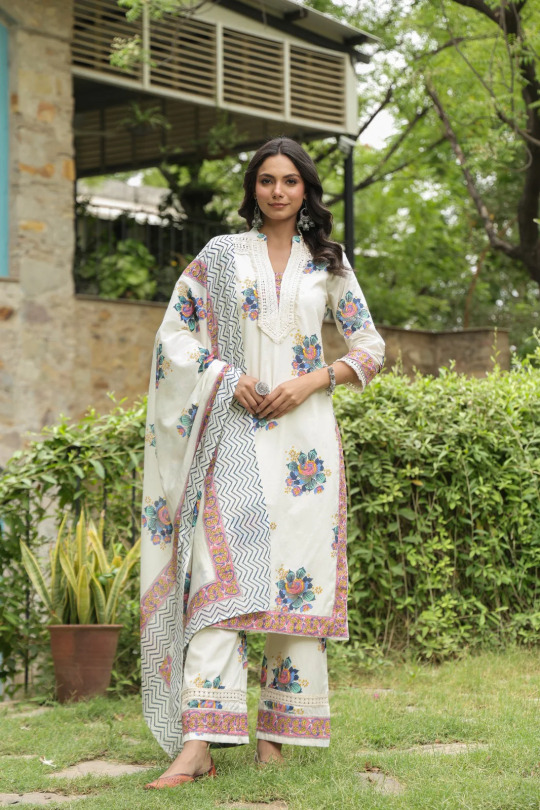
Day 6: Red
As we are halfway through, on the sixth day, wear the stunning Nayab Noor Maroon Muslin Kurta Set with Dupatta. The rich red colour is bold and festive, perfect for this spirited night. The luxurious silk fabric will make you feel special, while the intricate prints showcase the beauty of traditional craftsmanship.
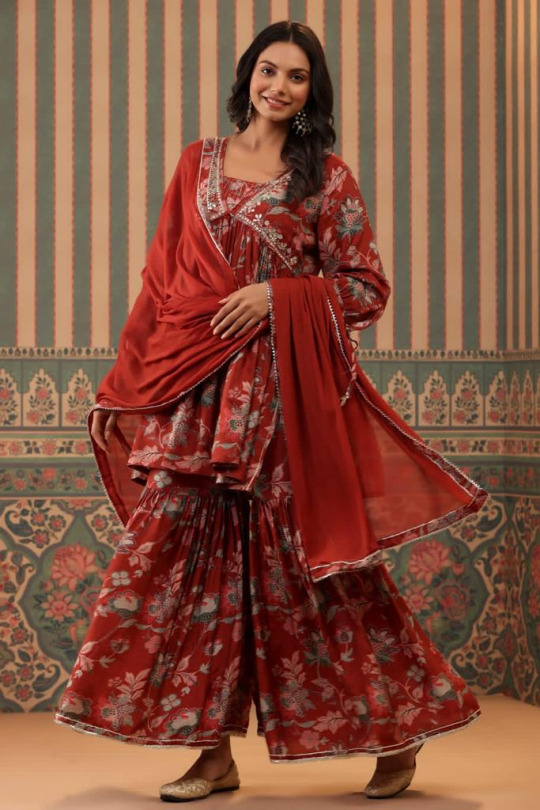
Day 7: Blue
For the seventh day, the Nayab Madhuri Aqua Floral Gharara Kurta Set With Dupatta offers a calm yet striking appearance. The blue tones create a beautiful contrast against the vibrant festivities. With block prints that tell a story, this kurta set is stylish and meaningful, making it a great choice for any Navratri event.
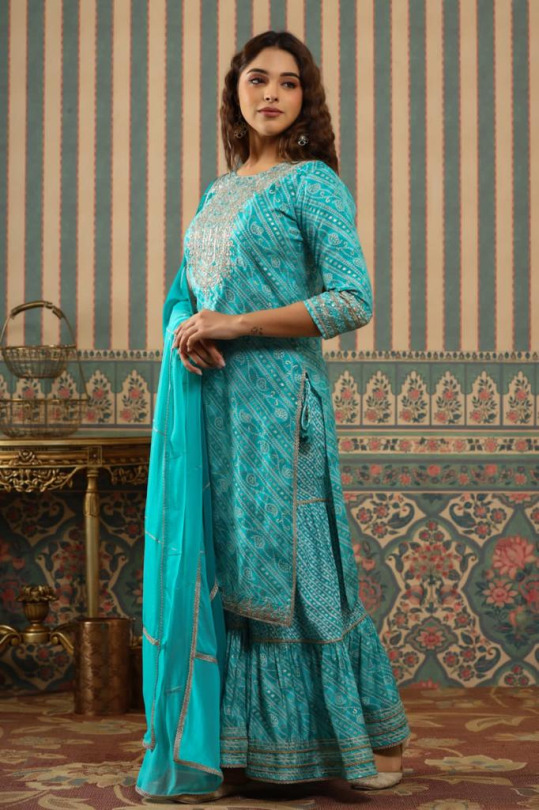
Day 8: Pink
Day eight is all about charm, and the Rooh Ruhani Pink Kurta Set with Dupatta is just that. This soft pink outfit radiates warmth and joy, making it perfect for the occasion. The flowy fabric and elegant design allow you to enjoy the night with ease, all while looking lovely.
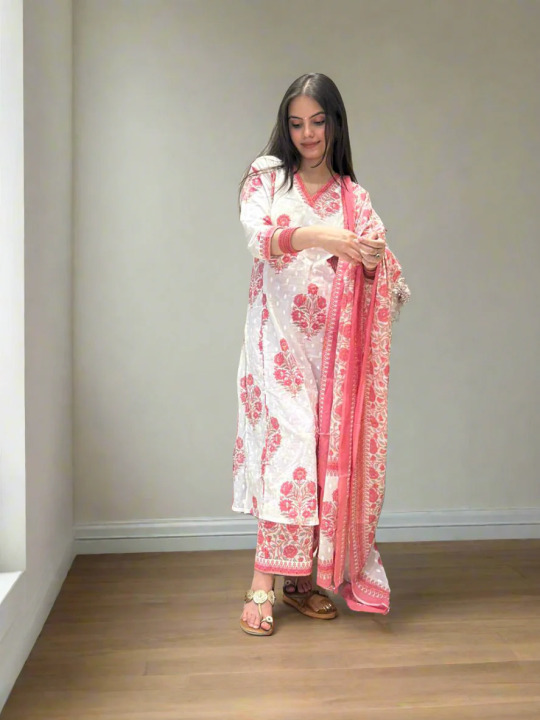
Day 9: Purple
Conclude the festival in style with the Nayab Madhuri Purple Floral Gharara Kurta Set. This gorgeous outfit features a stunning gharara style that is both trendy and traditional. The rich purple colour symbolizes luxury and creativity, making it a fitting finale for the celebrations.
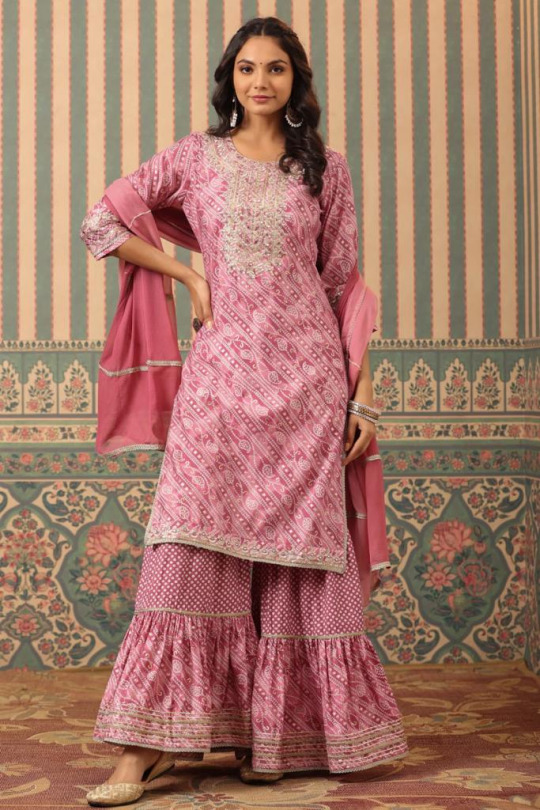
To sum up, as Navratri unfolds, these nine outfits will keep you stylish and comfortable throughout the festival. Each day’s colour not only reflects the spirit of the festival but also allows you to express your unique style. So, gear up, enjoy the festivities, and let your outfits tell a story!
#dress#online#indian print tops#india#cotton kurtis online#best cotton kurtis#designer kurti online#fashion#delhi#hinduism#mumbai
2 notes
·
View notes
Text
10 Beautiful Vocabulary for the Navratri Celebration

Navratri Spirit: Honoring Goddess Durga
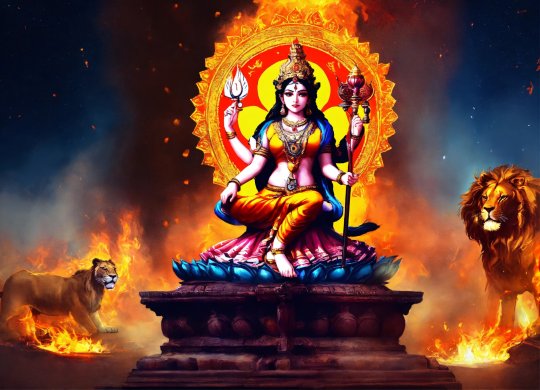
The vibrant spirit of India comes alive during Navratri, a nine-day festival that resonates with faith, festivity, and cultural grandeur. As the name suggests, "Nav" means nine and "Ratri" means nights. This festival is a joyous period steeped in beautiful traditions and customs. Let's delve into the dazzling world of Navratri with some exquisite vocabulary to enrich your understanding of this spectacular celebration.
1. Auspicious (au-spish-us)

Navratri is considered an extremely auspicious time. "Auspicious" signifies an occasion filled with good fortune and blessings. Devotees believe that prayers and observances undertaken during these nine nights hold special significance and bring prosperity.
2. Reverence (rev-er-ence)
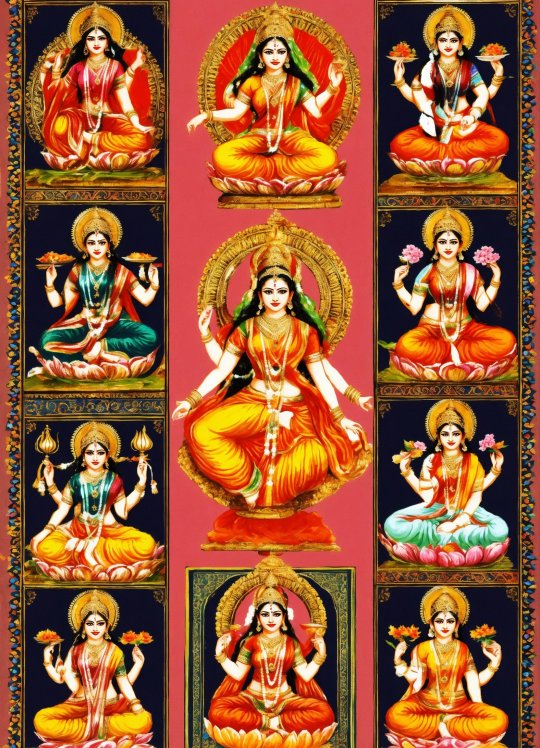
The nine days of Navratri are dedicated to worshipping the nine divine forms of Goddess Durga. "Reverence" refers to the deep respect and devotion offered to the Goddess. Hindus across the world observe pujas (prayers) and rituals with utmost reverence, seeking the blessings of Durga for strength, wisdom, and protection.
3. Panoply (pan-o-ply)

Navratri is a visual feast for the senses. Homes and pandals (temporary shrines) are adorned with vibrant decorations, creating a dazzling "panoply" of colors and textures. Imagine intricate rangolis (floor art), strings of marigolds, and shimmering diyas (lamps) – a true spectacle of beauty.
4. Ethereal (ee-the-ri-al)

The atmosphere during Navratri is charged with a sense of otherworldly beauty. "Ethereal" describes something delicate and heavenly, and this perfectly captures the feeling one gets amidst the chants, devotional music, and the gentle flickering of diya flames.
5. Resplendent (ri-splen-dent)

Devotees dress up in their finest attire during Navratri. "Resplendent" signifies being magnificently beautiful and radiant. Imagine sarees in rich silks, adorned with intricate jewellery – a dazzling display of cultural resplendence.
6. Gastronomical (gas-tro-no-mi-cal)
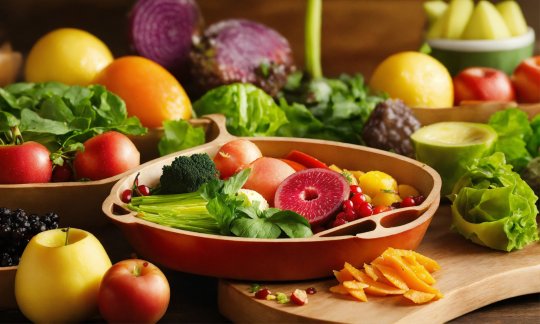
Navratri is a time to indulge in delicious vegetarian fare. "Gastronomical" refers to the art of good eating, and Navratri offers a plethora of delectable dishes specially prepared for the occasion. Think of flavorful sweets like halwa and savoury dishes like sabudana khichdi – a true treat for the taste buds.
CREATE YOUR DREAM BOOK NOW
7. Jubilant (joo-bi-lant)
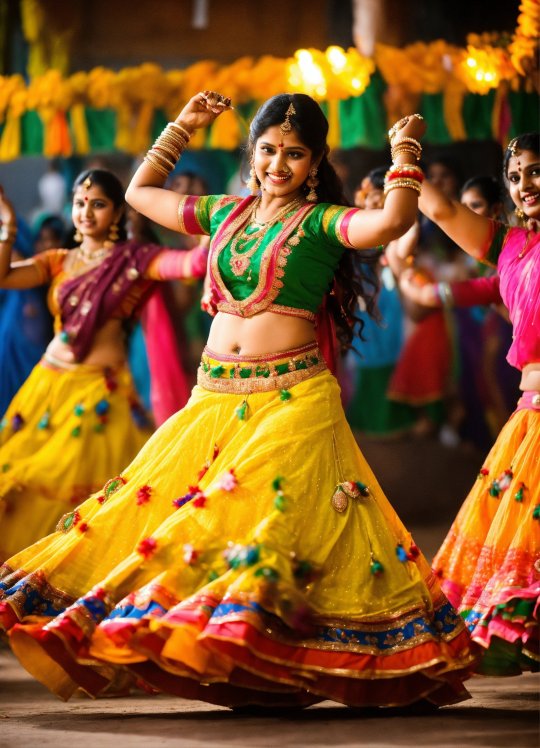
The spirit of Navratri is infectious. The air is filled with the sounds of laughter, music, and joyous celebrations. "Jubilant" describes a feeling of great happiness and triumph, perfectly capturing the mood of this vibrant festival.
8. Propitious (pro-pish-us)

The tenth day after Navratri, Dussehra, marks the victory of good over evil. "Propitious" signifies favorable or auspicious. Dussehra is seen as a day that ushers in good times and eliminates negativity.
9. Confluence (con-flu-ence)

Navratri transcends religious boundaries and brings people together. "Confluence" signifies a flowing together, and this beautifully captures the spirit of the festival. People from all walks of life come together to celebrate, share stories, and strengthen community bonds.
10. Euphoria (yoo-for-ee-ah)

Navratri leaves a lasting impression. "Euphoria" describes a feeling of intense happiness and excitement. The festival leaves devotees feeling uplifted, inspired, and carrying the positive energy forward throughout the year.
Beyond the Words: The Enchantment of Navratri
These words merely offer a glimpse into the magic of Navratri. The true essence of the festival lies in experiencing it firsthand. The aroma of incense filling the air, the rhythmic beats of the dhol (drum), the vibrant colours, and the feeling of community – all contribute to creating an unforgettable experience.
So, if you have the opportunity to witness Navratri, embrace it with open arms. Let yourself be enveloped by the joyous spirit, savour the delicious food, and appreciate the beauty of this time-honoured tradition. You might discover a new facet of Indian culture and return home with a heart brimming with "euphoria."
Don't miss out on our other blog posts!
2 notes
·
View notes
Text
Who is Lalita Mata, how did she originate?
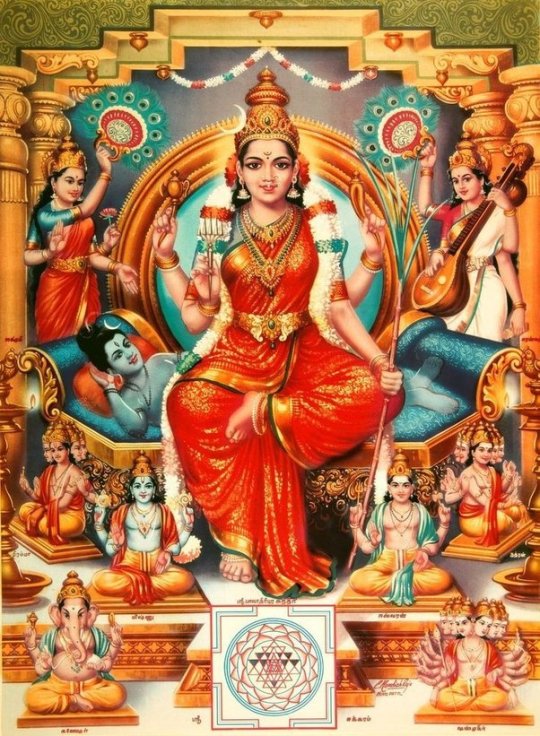
It is told in Brahmanda Purana that taking the name of Lord Shiva once gives the same result as taking the name of Maha Vishnu a thousand times. Similarly, taking the name of Mother Lalita once gives results equal to taking 1000 names of Lord Shiva. Let us know what we will know in today's article:-
1. Who is Lalita Mata?
2. How did Lalita Mata originate?
3. Mantra of Lalita Mata and 10 Mahavidyas
4. Benefits and advantages of reciting Lalita Chalisa
1. Who is Lalita Mata?
Lalita is the form of Mother Goddess Sati-Parvati. Lalita Mata is also known as Tripura Sundari, Shodashi and Lalita Tripurasundari. Mata Tripura Sundari is one of the 10 Mahavidyas.
There are three forms of Mother Lalita. Tripura Sundari in the form of an 8 year old girl, Shodashi at the age of 16 and the young form of mother Lalita is known as Tripura Sundari. Mother Lalita Tripura Sundari is expert in 16 arts, that is why she is also called Shodashi. Lalita Mata's birth anniversary is celebrated every year on the full moon date of Magh month. During Navratri, Lalita Panchami fast is observed along with Skandamata on the fifth day of Navratri. It is also called Upang Lalita Vrat. According to the Puranas, Lalita Mata has two arms. This mother is of fair complexion and is seated on a bloody lotus. According to the Dakshinamargi scriptures, Goddess Lalita has the place of 'Chandi'. Their method of worship is similar to that of Goddess Chandi. The meditative form of Goddess Lalita is very bright and luminous. Lalita Mata can be worshiped anytime but worshiping her on Lalita Jayanti or Lalita Panchami has special significance. On the day of Lalita Jayanti, there is a crowd of devotees of Mother Goddess in the temples. Skandamata and Lord Shiva are also worshiped on this day.
By worshiping Goddess Lalita, devotees attain happiness, prosperity and salvation. People become free from the bondage of life and death.
Lalita Mata's name comes third among the 10 Mahavidyas. The fast of Lalita Panchami is considered very auspicious and auspicious. It is believed that the person who worships Lalita Devi with true heart and full devotion gets the special blessings of Lalita Mata. Regarding this fast, Lord Shri Krishna has said that this fast is going to give happiness and wealth. Those who are childless get the happiness of having children. This fast is observed to pray for the happiness and long life of the child. Next we will know the mantra of Lalita Mata and which are the 10 Mahavidyas. But before that let us know the origin story of Lalita Mata.
2. How did Lalita Mata originate?
In the Puranas we find two stories about the origin of Lalita Mata. According to the story of Devi Purana, the story of origin of Lalita Mata is related to the sacrifice (death) of Mother Sati. Who is Goddess Sati? Let us know how the story of mother Lalita's origin is connected with her death.
Sati Ji, the incarnation of Mother Adishakti, is the daughter of Maharaj Daksh. When Sati saw Lord Shiva, she became fascinated by him and decided to marry him. Despite Maharaj Daksh not wanting, he married Sati to Lord Shiva.
Although Maharaj Daksh married Sati to Lord Shiva but he was not satisfied with that marriage. Mother Sati married as per her wish. Daksh did not like anything about Shivaji's behavior or attire.
Brahma Ji gave Maharaj Daksh the post of guardian of the people i.e. Prajapati. After getting the post of Prajapati, Maharaj Daksh became more arrogant. Often the attainment of great authority leads to arrogance in the mind. Who is like this in the world? One who is not intoxicated by attaining dominance. Once Brahma ji organized a religious assembly to formulate the religion. Great sages and gods were present in this religious gathering. Lord Shiva was also present in that meeting.
When Daksh Prajapati arrived there, all the sages, sages and gods stood up to welcome him. Only Brahma ji and Lord Shankar remained sitting at their places. Brahma ji is the mental father of Daksh Prajapati. Daksh bowed to Lord Brahma. Daksh Prajapati did not like Shankar ji sitting because Brahma ji was his father, hence he felt it was right for him not to stand, but Shiv ji was his son-in-law, so his not standing and not greeting him felt like an insult to Daksh. Prajapati Daksh was especially pained by the fact that his son-in-law Shankar ji did not salute him. Distressed by this, Maharaja Daksh strongly condemned Shankar ji. Shankar ji was called uncivilized and corrupt. They even cursed him that he would not get any part in any yagya. Even after this, Maharaj Daksh's anger did not subside.
Prajapati Daksh organized a huge yagya with the aim of humiliating Lord Shankar. All the sages, sages, gods and goddesses were invited to that yagya but Shankar ji and Mata Sati were not invited for the yagya. Seeing all the sages, sages and gods leaving in their respective planes, Goddess Sati asks Shankar ji where all these people are going. Then Lord Bholenath Shankar ji tells Devi Sati that your father Maharaj Daksh has organized a huge yagya. All these people are going to participate in that yagya. Goddess Sati said – Lord, I have not gone to my maternal home for a long time, a Yagya is being performed there, so my sisters will also definitely come. If you have permission, then both of us should also go there, even though they have not invited us, but it has been said that permission is not required to go to parents and teachers. Lord Shankar ji said that you are absolutely right that one does not need permission to go to parents and teachers. One can visit parents' and teachers' places even without inviting them. But here the matter is different. If someone believes in opposition then there is no benefit in going there. Maharaj Daksh does not like our coming there, he has deliberately not invited us, hence it would not be entirely appropriate to go there. Therefore, O Goddess, it would be appropriate to give up the idea of going there.
Even after the persuasion of Lord Shiva, Mother Sati started insisting on going to the Yagya. When Mother Sati did not agree, Lord Shankar ji sent her along with his followers Veerbhadra and Nandi. When Sati reached her peak, everyone started ignoring her. Maharaja Daksh did not show him any respect. When the sisters saw her, they started smiling sarcastically and said among themselves that look, Sati has come without invitation. There he met only his mother with love. When Goddess Sati came to the Yagyashala, she saw that all the gods had come there but no one had come there for Lord Shiva. Sati asks her father Maharaj Daksh why such contempt for Lord Shiva? Maharaj Daksh says very good and bad things about Shiva, he says that he does not consider Shiva as a god. He is the master of ghosts and devils. Gonna be naked. The one who applies crematorium ashes to his body and wears a garland of bones is not worthy of sitting in the ranks of the gods. Who will give him away? Hearing the words of Maharaj Daksh, Sati's eyes turned red in anger and she started saying that even if the name of Lord Shiva comes up in the context of conversation unexpectedly, all the sins of the person taking his name are destroyed. Who has the power to destroy the entire creation in a moment. They are my master. You hate Shiva like this. Your end is near, Maharaj.
For a woman, her husband is heaven. A woman who hears derogatory words about her husband has to go to hell. You have hatred towards Lord Shiva. Therefore, I will immediately abandon this body of mine, born from your intercourse, because this body is like a skeleton for me. Saying this, Sati meditated on Lord Shiva and burnt her body in the fire of Yagya Kund. Mother Sati's divine love for her husband is a great role model for women even today. Angered by her father's insult to her husband, Sati jumped into the Yagya Kund and sacrificed her life. It is from here that the story of Sati becoming Shakti begins. Seeing Mata Sati immolating herself in the Yagya Kund, Veerbhadra got angry and cut off Daksh's head and threw it away. When Lord Shiva came to know about this, he became distraught in love for Mother Sati and lost his senses. After this, Lord Shiva became sad and started the Tandava dance by carrying the body of Mother Sati on his head. He started roaming around the world carrying the dead body of Mata Sati on his shoulder. Due to this condition of Lord Shiva, the order of the entire world started deteriorating.
Seeing such a dire situation, Lord Vishnu was forced to cut the body of Mother Sati into pieces with his Sudarshan Chakra. After this, wherever the body parts of Mata Sati fell, Shakti from her body parts began to reside at those places in various forms and Shakti Peethas were formed there. In this way, wherever Sati's body parts and jewelery fell, Shaktipeeths came into existence.
There is mention of 108 Shaktipeeths in Devi Bhagwat, while 72 Shaktipeeths are mentioned in Devi Geeta. Whereas 51 Shaktipeeths have been discussed in Devi Purana. It is said that Mother Sati's heart had fallen in Naimishrai. Goddess Sati left her body with Lord Shankar in her heart. By keeping Lord Shankar in the heart, she is called by the name of Lalita. Therefore Naimish is considered to be a Linga Dharini Shakti Peetha place, here Lord Shiva is worshiped in the form of Linga and there is a temple of Mother Lalita Devi here.
3. Mantra of Lalita Mata and 10 Mahavidyas
Dasa Mahavidya – 10 forms of Goddess Shakti
1. Kali
2. star
3. Shodashi
4. Bhuvaneshwari
5. Bhairavi
6. Chhinnamasta
7. Dhumavati
8. Baglamukhi
9. Matangi
10. Kamala
Mantra of Lalita Mata:
'Om Shreem Hreem Kleem Ain Sau: Om Hreem Shreem Ka Ee La Hreem Ha S Ka Haal Hreem Sakal Hreem Sau: Aem Kleem Hreem Shreem Namah.'
4. Benefits and advantages of reciting Lalita Chalisa
Worship of any deity or god yields the desired results only when it is done with a true heart. We have written a separate detailed article on what are the benefits of reciting Shri Lalita Chalisa with full devotion and true heart. You can read that article by clicking below.
3 notes
·
View notes
Text
Explore the Latest Kanchipuram Silk Sarees Online
Kanchipuram silk sarees are the epitome of elegance, tradition, and craftsmanship. Known for their rich silk fabric and intricate zari work, these sarees are a go-to choice for weddings, festive occasions, and special events. With online shopping, exploring the latest Kanchipuram saree designs has never been easier. Let’s dive into why these sarees are so revered and how you can find the perfect one for your next big occasion.
Why Kanchipuram Silk Sarees Stand Out
What makes Kanchipuram silk sarees so special? The allure of these sarees lies in their flawless craftsmanship, vibrant colors, and the rich, pure silk fabric. Woven with care and precision, these sarees are renowned for their durability, glossy finish, and heavy borders that are often detailed with intricate designs. What sets Kanchipuram sarees apart from other silk sarees is the use of pure mulberry silk, which is woven with gold and silver zari threads, creating intricate patterns that reflect both tradition and grandeur.

The weaving technique itself is an art passed down through generations of skilled artisans. Each Kanchipuram saree takes days, sometimes weeks, to weave, ensuring that every design is perfectly crafted. The result is a saree that not only enhances your beauty but also tells the story of heritage and craftsmanship.
Latest Kanchipuram Saree Designs for Every Occasion
The world of Kanchipuram sarees has evolved, offering a wide range of styles for every occasion. From weddings to festive celebrations and even casual outings, there’s a design to suit every need.
Wedding Kanchipuram Silk Sarees
For weddings, Kanchipuram silk sarees are a quintessential choice. The latest wedding collections feature bold hues like red, maroon, gold, and emerald green, combined with delicate zari work that highlights the borders and pallu. These sarees are often embellished with traditional motifs such as peacocks, lotus flowers, and temple designs. Brides often choose Kanchipuram sarees for their rich, luxurious look that reflects their cultural roots.
With modern designs, brides are now embracing softer tones such as blush pink, pastel yellow, or off-white, while still maintaining the grandeur of Kanchipuram silk. These sarees are not only a statement piece for weddings but also make stunning attire for the wedding reception, offering both tradition and a touch of contemporary flair.
Festive and Party Wear Kanchipuram Sarees
Whether it’s a festival, a family function, or a party, the latest Kanchipuram saree designs are perfect for making a statement. These sarees come in rich shades like royal blue, golden yellow, and vibrant green, with intricate borders and pallu designs that bring a festive touch. For festivals like Diwali, Pongal, and Navratri, Kanchipuram sarees offer a perfect blend of tradition and modernity, often featuring light zari work, making them easier to wear for long hours.
For a more contemporary look, Kanchipuram sarees now incorporate bolder colors such as silver, lavender, and champagne, with minimalist zari borders for a modern twist.
Reception Kanchipuram Sarees
Reception sarees are typically more subdued yet still exude sophistication. Soft gold, ivory, peach, and light green are some of the trending shades in Kanchipuram silk sarees for reception parties. These sarees, while regal, have an understated elegance, perfect for making a refined yet impactful entrance.
Kanchipuram Saree Price: What Should You Expect?
When it comes to the Kanchipuram saree price, it can vary significantly depending on factors like the quality of the silk, the intricacy of the design, and the amount of zari work. Generally, the price range for Kanchipuram silk sarees starts at around ₹10,000 and can go up to ₹50,000 or more for high-end, bridal sarees.
The price often reflects the time and effort involved in hand-weaving these sarees, along with the quality of the materials used. While the sarees may seem pricey, their durability, elegance, and ability to stand the test of time make them a worthy investment.
For those on a budget, there are affordable options that still maintain the authenticity of Kanchipuram sarees without compromising on quality. Online platforms often offer seasonal discounts and special offers, making it easier to find a stunning saree within your price range.
How to Shop for Kanchipuram Sarees Online
Shopping for Kanchipuram sarees online offers the convenience of exploring a variety of designs from the comfort of your home. However, with the vast array of options available, here are some tips to ensure you make a great purchase:
1. Look for Trusted Platforms
When purchasing a Kanchipuram saree online, it’s essential to shop from trusted brands and platforms that guarantee authenticity. Always check for certification of authenticity or inquire about the provenance of the saree before making a purchase.
2. Check the Fabric and Zari Work
Ensure the saree is made from high-quality mulberry silk and features authentic zari work. The silk should be lustrous, and the zari should shimmer and shine without feeling too stiff.
3. Understand the Fit and Drape
Different sarees come in varying lengths and draping styles. Be sure to check the measurements and fabric details to ensure the saree fits your needs. Look for sarees that offer easy draping, especially if you plan on wearing it for long hours.
4. Explore the Latest Designs
With the variety of Kanchipuram saree designs available online, it’s easy to find one that aligns with your personal style. From bold, intricate designs to simpler, minimalist ones, there’s something for everyone.
Final Thoughts
Kanchipuram silk sarees are a symbol of timeless elegance, tradition, and craftsmanship. Whether you are buying a saree for your wedding, a festive occasion, or a special event, these sarees never fail to impress. The vibrant colors, intricate designs, and luxurious silk make them an heirloom piece that can be cherished for years. If you’re looking to buy the latest Kanchipuram silk sarees online, Samyakk offers a wide selection of authentic and exquisite sarees that bring both tradition and modernity to your wardrobe. Explore their collection today and add a touch of heritage to your ensemble!
Popular Searches: Saree || Saree Online || Saree for Women || Saree for Wedding || Kanchipuram Sarees || Kanjivaram Saree || Pure Silk Saree || Kanchipuram for Wedding || Banarasi Sarees || Designer Silk Saree || Pure Handloom Silk Saree || Gadwal Silk Saree || Paithani Silk Saree || Ikkat & Patola Saree || Kota Silk Saree || Patan Patola Silk Saree || Pashmina Sarees || Printed Silk Saree || Wedding Sarees || Festive Wear Saree || Party Wear Saree || Mehendi Sarees || Reception Sarees
#Saree#Sarees#Saree Online#Kanchipuram Saree#Kanchipuram Silk Saree#Kanjivaram Saree#Party Wear Saree#Silk Sarees
0 notes
Text
Amba Mata Temple: Worship with Stunning Views

Nestled in the serene hills of Rajasthan, Amba Mata Temple is a revered pilgrimage site dedicated to Goddess Amba, a manifestation of Shakti, the divine feminine energy. This ancient temple attracts thousands of devotees every year, not just for its spiritual significance but also for its breathtaking views of the surrounding landscape. In this article, we will explore the history, architecture, significance, and the experience of visiting the Amba Mata Temple. If you’re looking to visit this magnificent site, Shri Nakoda Tours & Travels, a leading Tour Operator in Udaipur, offers the Best Udaipur Tour Packages that include this and other iconic locations.
History of Amba Mata Temple
The history of Amba Mata Temple dates back several centuries. It is believed that the temple was constructed in the 8th century, although its exact origins remain unclear. The temple has been a place of worship for local residents for generations. Legend has it that Goddess Amba, who is regarded as a form of Durga, came to the rescue of her devotees during times of crisis. Over the years, many miraculous events associated with the goddess have strengthened the faith of her devotees.
The temple is situated on the Ambaji Hill, about 50 kilometers from the city of Udaipur. The hill is named after the goddess, and many believe that the area is infused with her spiritual energy. The temple has undergone several renovations and restorations, but it still retains its ancient charm. If you want to explore this fascinating history, consider booking one of the Best Udaipur Tour Packages offered by Shri Nakoda Tours & Travels.
Architectural Features
Amba Mata Temple showcases exquisite architectural features that reflect the rich heritage of Indian temple design. The temple is constructed using local stone, giving it a rustic yet majestic appearance. The entrance is adorned with intricate carvings and sculptures that depict various deities and mythological stories.
Upon entering the temple, visitors are greeted by a beautifully crafted idol of Goddess Amba. The idol is often draped in colorful garments and adorned with jewelry, making it a visual delight for the devotees. The sanctum sanctorum, where the idol resides, is an important place for worship. The temple also features several smaller shrines dedicated to other deities, creating a spiritual ambiance.
The temple's architecture is designed to harmonize with its natural surroundings. Large windows and open spaces allow for ample sunlight and provide breathtaking views of the hills and valleys surrounding the temple. This connection with nature enhances the spiritual experience for visitors. With Shri Nakoda Tours & Travels, you can enjoy guided tours that provide insights into the temple’s architectural beauty as part of their Best Udaipur Tour Packages.
Spiritual Significance
The Amba Mata Temple holds immense spiritual significance for its devotees. Many believe that offering prayers and performing rituals at the temple can bring peace, prosperity, and happiness. The goddess is worshipped as a protector who helps her devotees overcome obstacles and challenges in their lives.
One of the main festivals celebrated at the temple is Navratri, a nine-night festival dedicated to the worship of the goddess. During this time, the temple attracts a large number of devotees who come to seek blessings and participate in the vibrant celebrations. The atmosphere is filled with devotional songs, dance performances, and rituals, making it a joyous time for everyone involved.
Another significant event is the Maha Shivaratri festival, during which special prayers and ceremonies are conducted to honor Lord Shiva, who is often worshipped alongside Goddess Amba. The temple becomes a hub of activity, with devotees offering prayers, performing rituals, and seeking the blessings of the divine. To ensure a smooth and fulfilling experience during these festivals, you can rely on Shri Nakoda Tours & Travels, your trusted Tour Operator in Udaipur.
Journey to the Temple
Reaching Amba Mata Temple is an adventure in itself. The journey typically starts from Udaipur, which is well-connected by road and rail. Visitors can hire a taxi or take a bus to reach the temple. The drive takes about one to two hours, depending on the traffic and road conditions.
As you approach the temple, the scenery becomes more picturesque, with lush green hills and serene landscapes. The last stretch of the journey involves climbing a series of stairs leading up to the temple. This climb can be a bit challenging, but it is worth it for the stunning views that await you at the top. Along the way, there are various stalls selling snacks and religious items, adding to the vibrant atmosphere of the pilgrimage. Shri Nakoda Tours & Travels provides comfortable travel options as part of their Best Udaipur Tour Packages, ensuring that your journey is both enjoyable and memorable.
Experience of Visiting the Temple
Visiting Amba Mata Temple is a spiritually enriching experience. As you step into the temple complex, you will immediately feel a sense of peace and tranquility. The sound of devotional music fills the air, and the scent of incense adds to the atmosphere. Many devotees spend time in meditation and prayer, seeking solace and strength from the goddess.
The view from the temple is simply breathtaking. Standing at the temple's height, you can see the sprawling valleys and hills of Rajasthan. The changing colors of the landscape throughout the day, especially during sunrise and sunset, create a mesmerizing backdrop for worship. Many visitors take photographs to capture these stunning views, making memories that last a lifetime. With the help of Shri Nakoda Tours & Travels, you can enhance your experience by choosing from their diverse Best Udaipur Tour Packages that include visits to other scenic spots.
After offering your prayers, you can spend some time exploring the surrounding area. There are several viewpoints and trails nearby where you can enjoy nature and soak in the beauty of the landscape. Whether you're a nature lover or a spiritual seeker, the experience at Amba Mata Temple is fulfilling and can be tailored to your preferences with the assistance of a professional Tour Operator in Udaipur like Shri Nakoda Tours & Travels.
Local Cuisine and Accommodations
After a day of worship and exploration, indulging in local cuisine is a must. The region offers a variety of vegetarian dishes, including dal baati churma, gatte ki sabzi, and various types of sweets. Many small eateries and restaurants near the temple serve delicious food that caters to the taste of visitors.
For those who wish to stay overnight, there are several accommodation options available nearby. From budget guesthouses to more luxurious hotels, you can find a place that suits your needs. Staying close to the temple allows you to immerse yourself in the spiritual ambiance and enjoy the tranquility of the area. Shri Nakoda Tours & Travels can assist you in finding the best accommodations as part of their Best Udaipur Tour Packages to make your stay comfortable.
Conclusion
Amba Mata Temple is not just a place of worship; it is a destination that offers stunning views, rich history, and spiritual experiences. Whether you are seeking blessings, enjoying nature, or learning about the local culture, a visit to this temple is sure to leave a lasting impression. So, if you are planning a trip to Rajasthan, make sure to include the Amba Mata Temple in your itinerary. The combination of worship and breathtaking views makes it an unforgettable experience for everyone. For the best travel experience, consider Shri Nakoda Tours & Travels as your preferred Tour Operator in Udaipur. Their Best Udaipur Tour Packages will ensure that you explore this spiritual haven and its surroundings seamlessly.
0 notes
Text
Radha Krishna Jhanki Group in Madhepura Bihar
"Sargam Jagran Party" is the best in Jagran, Chowki, Bhajan & Sai Sandhya, Khatu Shyam Bhajan, Ladies Sangeet & all Devotee type program in Lucknow, UP, India. ☎+91-9919805315. "Sargam Jagran Party" has been conducting Mata ki Chowki, Mata ka Jagran and Bhajan Sandya from last 10 years with lots of memories and with great success.Blessing of God and Goddess is needed to overcome every rough course of life. Everyone should conduct Mata Ki Chowki and Mata Ka Jagran to get blessing and her devine power and all the needs to be fulfilled.

" Sargam Jagran Party" is very much devotional event organiser, as it is done with full devotion and respect towards the God. The work of the "Sargam Jagran Party" has been appreciated and acknowledged in many State Newspaper like: UP, Bihar, Rajsthan and Hariyana etc. At the very first place it was started with the same group but, now it has expand upto 30 plus people. All the facilities are provide which are needed to conduct Mata ki Chowki, Mata ka Jagran and Bhajan sandhya like: Singer's, Instruments, Sound facility, Jhanki etc. We are often called by the people again and again who have used our services.
youtube
Poeple mostly like to call us at the time of Weeding, Engagement, Birthdays, Anniversaries or during Ganpati Pooja and Navratri festivals and we promised to serve a memorable Jagran or Chowki. Working for over a decades, we are having the experience to make it more devotional and memorable when we organised it. Our party has experienced chorus group, vocalist, musicians and artists which are required to make it successful. Its main origin is based in Lucknow and we operate almost all the States in India. Pooja Sargam is the Director and also a Lead Singer of the "Sargam Jagran Party" organiser. Starting from the Pooja Aarti to the Bhog or Prasad everything is done by our organie team.

From last 10 years we are providing the best Mata Ki Chowki, Mata Ka Jagran and Bhajan Sandhya also currently dealing in the Lucknow (Uttar Pradesh) and to the another State's.
So next time whenever you are planing to conduct Mata Ki Chowki, Mata Ka Jagran and Bhajan Sandhya, make sure to contact us and make your spiritual experience more devotional and delightfull.
youtube
Mata ka Jagran is a holy programme for all the Hindu community. In this programme all night Kirtan has been sung by the singers and Maa Durga worship has been done.
At Mata ka Jagran firstly we light Akhand jyoti of Mataji. After that Vandana is sung ( devotional song) by the singer or any other devotee who wants to sing. Bhet is offered by the devotee (red color chunni) coconut fruits and shingar matriail along with soe bheta and sweets. Then comes ardass and bhog is distributed to the people who are present there by the devotee. Short break are taken and around half an hour again we start for the further process. Lastly after Aarti and devotional song’s Lonkra and Kanjak Pooja we distribute bhog and Prasad to all and comes to the end of Jagran as an samapti.

Mata ki chowki represent the ancient culture of Hinduism society. Mata ki chowki means praising the stories of Gods life time experiences in the form of singing. It is generally sung in Sanskrit and Hindi. It is a devotional programme conducted specially for occasions like Weeding, Engagement, Birthdays, Anniversaries or during Ganpati Pooja and Navratri festivals. In Mata ki Chowki Short time kirtan is conducted in Mata Ki Chowki and it is mostly for 4 to 5 hours. Prayee devote their respect through their prayers in the form of singing. Garlands and Matajis bhet (red color chunni) coconut and shingar with bheta. After that Aarti is done by the devotee who has kept Mata Ki Chowki. Bhog Prasad to Mataji of Kher has been offered followed by Amrit Varsha and Phoolon Ki Varsha of flowers and petals. At last prasand is shared to all people who have been there as the samapti of Mata Ki CHowki.
youtube
#event#eventmanagement#mata ki chowki#kirtan#sai sandhya#chowki#khatu shyam bhajan#jagran#bhajan sandhya#youtube#Youtube
0 notes
Text

Day 7: Saptami | Celebrating Maa Kalaratri: Goddess of Protection✨
On this special day of Navratri, we honor Goddess Kalaratri, known for Ensuring safety and protection is paramount.🙏✨
Mantra: ओम ऐं ह्रीं क्लीं चामुण्डायै विच्चै ऊं कालरात्रि दैव्ये नम:।
The seventh day of Navratri is dedicated to Goddess Kalaratri, the fierce protector who shields us from harm. Similarly, ensuring the safety and protection of children with autism is a key priority for caregivers and educators.
Here are some essential safety measures and strategies to keep in mind:
Create a Safe Environment: Childproof your home and play areas by removing potential hazards and using safety locks and barriers.
Establish Safety Routines: Develop clear routines that help children understand safe and unsafe situations, such as not touching hot surfaces or crossing the street alone.
Sensory-Friendly Safety Tools: Use sensory-friendly safety gear like earmuffs or weighted blankets during overwhelming situations to provide comfort and security.
Teach Safety Skills: Practice safety drills like what to do in case of a fire or an emergency. Reinforce these skills with visual aids and social stories.
Monitor Social Interactions: Be vigilant about your child’s interactions, especially in new environments. Teach them to communicate clearly if they feel uncomfortable.
Goddess Kalaratri protects us from darkness and fear. Let’s embody her spirit by creating a safe and nurturing environment for our loved ones.
Remember, progress is a symphony of small victories. At Lalan Autism Clinic in #Ranchi, we celebrate each achievement, knowing that it unlocks a world of possibilities. 🌈🏃♂️
For more information or to begin your child’s healing journey, visit our website: Lalan Autism - Academy of Autism & Child Physiotherapy
🌐https://lalanautism.com/ 📩 [email protected] 📲+91-9899272246
#applied behavior analysis#autism#helth care#jharkhand#physiotherapy#ranchi#speech therapy#asd#autism spectrum#bihar
1 note
·
View note
Text
06/10/2024: NAVARATHRI SPECIAL
NAVARATHRI SPECIAL This week’s Sunday Story Number3659 is on an auspicious theme. Navratri Day 1: Yellow (Shailaputri) The “daughter of the mountains”, Shailaputri, is worshipped on the first day of Navratri. As the first incarnation of Goddess Durga, she embodies purity and nature. Wearing yellow on this day signifies a person with lively and warm characteristics. This vibrant colour radiates…

View On WordPress
0 notes
Text
Navratri 2024: Subh Muhurat, Fasting Guide, And Durga Mata Avatars | Hi Retails

Navratri, one of the most celebrated Hindu festivals, is a nine-day spiritual journey dedicated to the worship of Goddess Durga. Observed twice a year, this festival symbolizes the victory of good over evil and holds immense cultural and religious importance. In this blog, we will dive deep into the Subh muhurat of Navratri, its significance, the nine forms of Durga, fasting rituals, and the special role of brass products and kansa thalis in Navratri rituals.
Subh Muhurat for Navratri 2024
Navratri, starting from October 02, 2024, marks the beginning of a sacred period. According to Hindu traditions, the auspicious time (Subh Muhurat) for Ghatasthapana, the first day ritual, begins between 6:27 AM to 7:48 AM on the first day. This muhurat holds special significance as devotees place kalash, brass or copper pots filled with holy water, symbolizing the universe, on their prayer altars.
Using brass items during this time, like brass water bottles, pooja thali sets, and brass god idols, is considered auspicious, as brass and copper are believed to purify the environment, enhancing the positive energy during the rituals.
The Importance of Navratri
Navratri represents the triumph of righteousness. It commemorates the goddess Durga’s battle against the demon Mahishasura, a powerful force of evil. Each of the nine days signifies different aspects of Goddess Durga, and devotees observe rituals, prayers, and fasting to seek her blessings. During this sacred period, traditional items like kansa thalis and brass pooja items hold significant value, connecting devotees with ancient customs and purifying the energy around.
Many devotees prefer using brass idols for decoration during this period. You can find brass idols of Hindu gods online to decorate your home and enhance the spiritual atmosphere.
Fasting During Navratri: A Spiritual Practice
Navratri fasting is not just a religious duty but also a method of detoxifying the body and mind. Here’s how to do fasting during Navratri:
What to Eat: Devotees typically consume fruits, dairy, and specific grains like buckwheat and water chestnut flour. Drinking water from brass water bottles is believed to keep the body purified.
Spiritual Benefits: Fasting helps in self-discipline and allows devotees to focus on prayer and meditation, helping to connect with the divine. Eating from kansa thalis during this period is said to boost immunity and promote overall health. The Story Behind Navratri The legend of Navratri revolves around Goddess Durga’s battle against Mahishasura, the buffalo demon. Mahishasura was granted a boon that made him invincible, except against a female warrior. His tyranny over the three worlds led to chaos, and the gods sought the help of Goddess Durga. Over nine days, Durga fought relentlessly and, on the tenth day, defeated Mahishasura, symbolizing the triumph of good over evil.
This victory is celebrated with fervor, and brass god idols, brass god statues, and decorative pooja items are used to adorn homes and temples in reverence to the goddess.
Nine Avatars of Durga: The Significance of Each Day
Day 1: ShailaputriThe daughter of the mountains, symbolizing strength. Devotees often use a decorated pooja thali to start their prayers on this day.
Day 2: BrahmachariniGoddess of austerity, symbolizing devotion. Fasting on this day while drinking water from a pure brass water bottle enhances inner peace.
Day 3: ChandraghantaThe warrior goddess symbolizes courage and bravery. Traditional aarti plates like decorated aarti thalis are used for puja.
Day 4: KushmandaThe creator of the universe. Brass god idols are ideal for worship on this day, helping to attract positive energy.
Day 5: SkandamataMother of Lord Skanda, symbolizing motherhood. Devotees use pooja thali sets for the rituals.
Day 6: KatyayaniDestroyer of evil, symbolizing protection. A brass idol of Durga is often placed for prayers.
Day 7: Kalaratri Goddess of destruction of negativity. Traditional aarti thalis are used for prayers.
Day 8: MahagauriThe symbol of purity and calmness. A brass idol of Lakshmi is ideal for prayers on this day.
Day 9: Siddhidatri Goddess of supernatural powers, worshipped for blessings. Using a kansa thali during the puja rituals is considered auspicious
The Importance of Brass Products and Kansa Thali in Navratri
Brass and kansa (bronze) have been integral to Hindu rituals for centuries due to their health benefits and spiritual significance. Here’s why they are crucial for Navratri:
Brass Pooja Thalis: A pooja thali set made of brass is essential for offering prayers. Brass is believed to have the power to attract divine energies, making it ideal for worship rituals.
Kansa Thalis: Eating from a kansa thali is recommended during Navratri fasting as it balances the body’s pH levels and improves digestion. These thalis are also used during ceremonial feasts, further connecting devotees to traditional practices.
Brass God Idols: Brass idols of deities such as Durga, Lakshmi, and Saraswati are revered for their purity and are often placed in homes and temples. Buying brass idols online is convenient for those looking to decorate their spaces with divine statues.
Health Benefits: Drinking water from a brass bottle is known to purify the water and improve health. Using brass and copper items during Navratri enhances the spiritual atmosphere and brings peace and prosperity to the home.
Conclusion
Navratri is more than just a festival; it’s a time to reflect on inner strength, devotion, and purity. Using brass products, from pooja thalis to brass god idols, enhances the sacredness of your rituals and keeps you connected to your cultural roots. This festive season, embrace tradition by using kansa thalis and brass items, which bring both health and spiritual benefits.
If you’re looking for authentic brass and copper items or a pooja thali online, visit Hi Retails. Our curated collection of pure brass products, including brass god idols and decorative brass gift items, will elevate your Navratri celebrations. Hi Retails Wishes you and your family a very divine Navaratri and spiritual journey with the purity of brass!
#home decor#navratri 2024#Durga maa#HIretails#Pooja thali#sprituality#unique gifts#festival#diwali#traditional art#brass#brass products#explore#explore page
0 notes
Text


*The makers of Ramanand Sagar ‘s Ramayan releases 'Jai Mata Vaishno Devi Ki' this Navratri Season*
After the legendary success of Ramanand Sagar’s Ramayan on Doordarshan that has broken records in terms of viewership even during the covid lockdown. Once again the national channel of the country, have joined hands Sagar World Multimedia & Aerika Cineworks to create the magic and light up your TV screens this Navratri season.
Presented by Shri J.C. Chaudhry, Produced by Prem Sagar, Neelam Sagar and Shiv Sagar, Co-Produced by Aakash Chaudhry and Aashish Chaudhry, Directed by Dharmesh Shah will be telecast on prime time 7:30pm and 10:30 pm and repeat telecast 7:00 am and 12:00 pm on DD slot from 2nd October 2024 as a part of Navratri celebrations. The show with 11 episodes showcases the divine love saga between Shri Ram and Mata Vaishno which plays a pivotal part in our Indian mythology. This Navrati season is going to be special with this devotional tale and witnessing a saga that we all have grown up hearing from our forefathers.
The series not only delivers a story that is unforgettable but also shall give audiences glimpses of the picturesque locations across Gujarat, Maharashtra, Jammu & Kashmir and Vrindavan. The makers have shot the entire series in a challenging period of 50 days including indoor and outdoor shoot schedules post the second Covid wave.
The series has been inspired by the famous book 'Vaishno Devi – Jammu' by renowned journalist Shri Suraj Saraf. It also captures the journey of Maa Vaishnodevi from Ratnagiri to Tirkut Parbat where she dwells at present waiting for Shri Ram in the ‘Kalki’ avatar. The series is unmissable and is perfect to sit together with your family and watch and celebrate Navratri season with a story that encompasses devotion and love.
The creative director and screenplay writer for the series is Shiv sagar, grand-son of the late Dr Ramanand sagar who was involved as a creative producer and director in shows like “Mahima shani Devi ki” “jai bajrang Bali” 3-d movie “arasuri maa Ambe” (in which Shri Amitabh bachchan gave the voice-over) etc. Currently Shiv is producing Kakbhusundi Ramayan for DD National to be telecast as a daily from next month.
0 notes
Text
Celebrating Navratri: A Journey Through Tradition, Culture, and Festivities.
Introduction to Navratri

Navratri, one of the most significant festivals in India, is celebrated with immense enthusiasm and devotion. Derived from Sanskrit, the word “Navratri” means “nine nights,” symbolizing the nine-day festival dedicated to the worship of Goddess Durga and her nine forms. It is celebrated in different ways across India, reflecting the country’s diverse traditions and customs. Because of its cultural significance, Navratri brings together communities to honor the divine feminine, celebrate victory over evil, and rejoice in vibrant festivities.
The Spiritual Significance of Navratri
The spiritual aspect of Navratri is deeply rooted in the triumph of good over evil. Each day is dedicated to a different form of Goddess Durga, representing the universal energy that protects and nurtures the world. For instance, the first three days are devoted to Durga, the next three to Lakshmi, and the final three to Saraswati, symbolizing strength, wealth, and wisdom, respectively. Therefore, Navratri is not just about rituals but also a time for personal reflection and inner growth.
Regional Variations of Navratri Celebrations

While Navratri is celebrated across India, each region adds its unique flavor to the festivities. In Gujarat, for example, the festival is synonymous with Garba and Dandiya, vibrant folk dances performed to traditional music. In contrast, West Bengal celebrates Durga Puja with grand pandals, artistic idols, and cultural performances. So, whether you’re in the North, South, East, or West of India, Navratri offers a blend of devotion, art, and culture that varies from place to place, making it a truly pan-Indian celebration.
Navratri Rituals and Practices
During the nine days, devotees observe various rituals, including fasting, special prayers, and offerings to the goddess. Many people also decorate their homes with colorful rangoli and light lamps to welcome prosperity. Because each day is dedicated to a specific form of the goddess, the rituals are often accompanied by chants, bhajans, and storytelling sessions that recount the stories of Durga’s victories. These practices help devotees feel more connected to the divine and instill a sense of unity within families and communities.
The Cultural Extravaganza of Garba and Dandiya
One of the most anticipated parts of Navratri is the Garba and Dandiya nights, especially in Gujarat and Maharashtra. Garba, a traditional dance form, is performed in a circular motion around a central lamp or an image of Goddess Durga. Similarly, Dandiya is a dance that involves pairs using decorated sticks to create rhythmic beats. Therefore, these dance forms are not just entertaining but also deeply symbolic, representing the eternal cycle of life and the interplay of divine forces. Because of their energetic nature, these dances attract people of all ages and backgrounds.
Food and Fasting During Navratri
Navratri is also known for its unique fasting traditions. Many people observe fasts for nine days, eating only specific foods such as fruits, nuts, and dairy products. The consumption of grains, meat, and certain spices is avoided as part of the religious observance. However, these restrictions have led to the creation of delicious, innovative fasting recipes. So, while fasting is a spiritual practice, it is also a culinary journey, with each region offering its own Navratri specialities like sabudana khichdi, kuttu puri, and aloo chaat.
The Role of Women in Navratri
Navratri is especially significant for women, as the festival celebrates the feminine aspect of divinity. Many women take a lead role in organizing prayers, preparing offerings, and performing rituals. In some parts of India, young girls, seen as embodiments of the goddess, are worshipped in a special ritual known as “Kanya Puja.” Because Navratri is a festival honoring female power, it highlights the importance of women in both the religious and social spheres, fostering a sense of respect and equality.
Modern-Day Navratri: A Blend of Tradition and Contemporary Celebrations
In recent years, Navratri has evolved to incorporate modern elements while still maintaining its traditional roots. Today, many urban areas organize large-scale Garba and Dandiya events that attract celebrities and use modern music and lighting. Therefore, Navratri has become not only a religious festival but also a cultural event that bridges the gap between generations. Whether in villages or cities, the spirit of Navratri remains the same — one of joy, togetherness, and devotion.
Conclusion: The Enduring Spirit of Navratri

Navratri is a time of unity, devotion, and celebration. Its rich blend of rituals, dance, music, and food reflects the diverse cultural heritage of India. So, as we celebrate Navratri year after year, we are reminded of the values it upholds — resilience, faith, and the triumph of good over evil. Because of its universal themes, Navratri continues to inspire people across the world, fostering a deep sense of community and connection to tradition.
0 notes
Text
How to Create a Thematic Golu Display: Ideas and Inspirations for Navratri

Navratri is a celebration of culture, tradition, and devotion, and one of the highlights of the festival is the Golu display. Creating a thematic Golu display can make this festive experience even more special and memorable. Whether you’re a seasoned enthusiast or setting up your first Golu, here are some ideas and inspirations to help you create a captivating display.
1. Choose a Theme: Selecting a theme is the first step in creating a Golu display that tells a story. Popular themes include mythological stories like "Krishna Leela," "Ramayana," or even contemporary ones like "India's Independence Journey." The theme helps in bringing focus and coherence to the display.
2. Use Creative Staging: Arrange your Golu dolls on tiers or steps, typically in odd numbers such as 3, 5, 7, or 9. To add depth and interest, use elements like miniature backgrounds, creative lighting, and handmade decorations. Adding small landscapes, like a model village or a garden, can bring more life to the setup.
3. Add Personal Touches: Incorporate handmade dolls, craft items, and other personal elements to make your Golu display unique. Including scenes from daily life or cultural celebrations adds a contemporary flair to the traditional setup.
4. Incorporate Spirituality: Display traditional puja items, such as kalash, diyas, and idols of deities, to enhance the spiritual ambiance. Including a prayer corner dedicated to daily puja during Navratri can add to the devotional atmosphere.
At pujanpujari.com, you can find all the puja items you need to enhance your Golu display. We also offer astrology services, online pandit booking, and customized puja packages to make your Navratri celebration truly special. Visit our website to explore our offerings and bring the divine spirit into your home.
0 notes
Text
Exploring the Sweet Tradition of Athirasam: India’s Ancient Dessert
In the vast panorama of Indian sweets, a few have a storied history as rich and as sweet as Athirasam. This traditional dessert, which traces its origins back to at least 1000 years, holds a special place in the hearts of many, particularly in the southern regions of India. As Diwali approaches, kitchens begin to buzz with the preparations of this beloved sweet, a testament to its enduring presence in Indian festivities.
The Historical Roots of Athirasam Athirasam, also known as Adhirasam in some parts of South India, is more than just a dessert; it is a slice of culinary history. References to this sweet can be found in ancient scriptures and texts, suggesting that it has been part of Hindu festivals and rituals for centuries. The making of Athirasam was traditionally linked to important occasions, serving as a sacred offering in temples and a festive delicacy at home.
Ingredients and Preparation The beauty of Athirasam lies in its simplicity. The sweet is made from just a handful of ingredients, primarily rice flour and jaggery. The rice is soaked overnight, finely ground, and then mixed with jaggery syrup spiced with cardamom. This dough is then rested, sometimes for days, allowing the flavors to meld. The critical aspect of Athirasam preparation is the consistency of the jaggery syrup, which should be perfect to achieve the desired texture. The dough is then shaped into small, flat discs and deep-fried in ghee or oil until they turn a dark, caramel color. The skill lies in frying the Athirasam to a point where it is neither too crisp nor too soft but has a slightly chewy texture that melts in the mouth.
Cultural Significance Athirasam is more than a culinary treat; it's a cultural symbol. It is prominently featured during Diwali and other Hindu festivals such as Ganesh Chaturthi and Navratri. In Tamil Nadu, it is a customary bridal sweet, presented during weddings as a part of the festivities and as a gesture of good luck for the newlyweds. Each region has its own twist on the basic recipe, which might include variations in the type of jaggery used, the addition of coconut or sesame seeds, or adjustments in the spice blend. Despite these variations, the essence of Athirasam as a celebratory sweet remains consistent across boundaries.
Health Aspects In today’s health-conscious world, Athirasam, like many traditional sweets, is enjoyed in moderation. Made from unrefined jaggery and rice flour, it offers more than just empty calories. Jaggery is a good source of iron and can aid digestion, while rice flour is gluten-free, making it a suitable option for those with gluten intolerance.
The Art of Making Athirasam Making Athirasam is considered an art, often passed down through generations within families. It requires practice and patience, as the process is as much about timing and technique as it is about the ingredients. The challenge of getting Athirasam right—achieving the perfect texture and flavor balance—makes it all the more special for those who undertake the task.
Conclusion Athirasam continues to be a cherished treat, its recipe guarded and passed down with pride. Each bite of this sweet is a taste of history, a reminder of the rich cultural tapestry of India and its age-old traditions of sweet making. As modern culinary trends evolve, the timeless appeal of Athirasam remains unchanged, making it a true classic of Indian cuisine. For those looking to experience the joy of making and tasting Athirasam, there is no better time than now to delve into this sweet endeavor. Whether enjoyed
0 notes
Text
Radha Krishna Jhanki Group in Godhra Gujarat
"Sargam Jagran Party" is the best in Jagran, Chowki, Bhajan & Sai Sandhya, Khatu Shyam Bhajan, Ladies Sangeet & all Devotee type program in Lucknow, UP, India. ☎+91-9919805315. "Sargam Jagran Party" has been conducting Mata ki Chowki, Mata ka Jagran and Bhajan Sandya from last 10 years with lots of memories and with great success.Blessing of God and Goddess is needed to overcome every rough course of life. Everyone should conduct Mata Ki Chowki and Mata Ka Jagran to get blessing and her devine power and all the needs to be fulfilled.

" Sargam Jagran Party" is very much devotional event organiser, as it is done with full devotion and respect towards the God. The work of the "Sargam Jagran Party" has been appreciated and acknowledged in many State Newspaper like: UP, Bihar, Rajsthan and Hariyana etc. At the very first place it was started with the same group but, now it has expand upto 30 plus people. All the facilities are provide which are needed to conduct Mata ki Chowki, Mata ka Jagran and Bhajan sandhya like: Singer's, Instruments, Sound facility, Jhanki etc. We are often called by the people again and again who have used our services.
youtube
Poeple mostly like to call us at the time of Weeding, Engagement, Birthdays, Anniversaries or during Ganpati Pooja and Navratri festivals and we promised to serve a memorable Jagran or Chowki. Working for over a decades, we are having the experience to make it more devotional and memorable when we organised it. Our party has experienced chorus group, vocalist, musicians and artists which are required to make it successful. Its main origin is based in Lucknow and we operate almost all the States in India. Pooja Sargam is the Director and also a Lead Singer of the "Sargam Jagran Party" organiser. Starting from the Pooja Aarti to the Bhog or Prasad everything is done by our organie team.
From last 10 years we are providing the best Mata Ki Chowki, Mata Ka Jagran and Bhajan Sandhya also currently dealing in the Lucknow (Uttar Pradesh) and to the another State's.
So next time whenever you are planing to conduct Mata Ki Chowki, Mata Ka Jagran and Bhajan Sandhya, make sure to contact us and make your spiritual experience more devotional and delightfull.

Mata ki chowki represent the ancient culture of Hinduism society. Mata ki chowki means praising the stories of Gods life time experiences in the form of singing. It is generally sung in Sanskrit and Hindi. It is a devotional programme conducted specially for occasions like Weeding, Engagement, Birthdays, Anniversaries or during Ganpati Pooja and Navratri festivals. In Mata ki Chowki Short time kirtan is conducted in Mata Ki Chowki and it is mostly for 4 to 5 hours. Prayee devote their respect through their prayers in the form of singing. Garlands and Matajis bhet (red color chunni) coconut and shingar with bheta. After that Aarti is done by the devotee who has kept Mata Ki Chowki. Bhog Prasad to Mataji of Kher has been offered followed by Amrit Varsha and Phoolon Ki Varsha of flowers and petals. At last prasand is shared to all people who have been there as the samapti of Mata Ki CHowki.
youtube
#balajikajagran#bhajankirtan#maabhagwatikajagran#saisandhya#bhajansandhya#lucknow#matakichowki#chowki#bhajan#youtube#Youtube
0 notes
Text
Radha Krishna Jhanki Group in Jehanabad Bihar
"Sargam Jagran Party" is the best in Jagran, Chowki, Bhajan & Sai Sandhya, Khatu Shyam Bhajan, Ladies Sangeet & all Devotee type program in Lucknow, UP, India. ☎+91-9919805315. "Sargam Jagran Party" has been conducting Mata ki Chowki, Mata ka Jagran and Bhajan Sandya from last 10 years with lots of memories and with great success.Blessing of God and Goddess is needed to overcome every rough course of life. Everyone should conduct Mata Ki Chowki and Mata Ka Jagran to get blessing and her devine power and all the needs to be fulfilled.

Poeple mostly like to call us at the time of Weeding, Engagement, Birthdays, Anniversaries or during Ganpati Pooja and Navratri festivals and we promised to serve a memorable Jagran or Chowki. Working for over a decades, we are having the experience to make it more devotional and memorable when we organised it. Our party has experienced chorus group, vocalist, musicians and artists which are required to make it successful. Its main origin is based in Lucknow and we operate almost all the States in India. Pooja Sargam is the Director and also a Lead Singer of the "Sargam Jagran Party" organiser. Starting from the Pooja Aarti to the Bhog or Prasad everything is done by our organie team.
From last 10 years we are providing the best Mata Ki Chowki, Mata Ka Jagran and Bhajan Sandhya also currently dealing in the Lucknow (Uttar Pradesh) and to the another State's.
So next time whenever you are planing to conduct Mata Ki Chowki, Mata Ka Jagran and Bhajan Sandhya, make sure to contact us and make your spiritual experience more devotional and delightfull.
youtube
Mata ka Jagran is a holy programme for all the Hindu community. In this programme all night Kirtan has been sung by the singers and Maa Durga worship has been done.
At Mata ka Jagran firstly we light Akhand jyoti of Mataji. After that Vandana is sung ( devotional song) by the singer or any other devotee who wants to sing. Bhet is offered by the devotee (red color chunni) coconut fruits and shingar matriail along with soe bheta and sweets. Then comes ardass and bhog is distributed to the people who are present there by the devotee. Short break are taken and around half an hour again we start for the further process. Lastly after Aarti and devotional song’s Lonkra and Kanjak Pooja we distribute bhog and Prasad to all and comes to the end of Jagran as an samapti.

Mata ki chowki represent the ancient culture of Hinduism society. Mata ki chowki means praising the stories of Gods life time experiences in the form of singing. It is generally sung in Sanskrit and Hindi. It is a devotional programme conducted specially for occasions like Weeding, Engagement, Birthdays, Anniversaries or during Ganpati Pooja and Navratri festivals. In Mata ki Chowki Short time kirtan is conducted in Mata Ki Chowki and it is mostly for 4 to 5 hours. Prayee devote their respect through their prayers in the form of singing. Garlands and Matajis bhet (red color chunni) coconut and shingar with bheta. After that Aarti is done by the devotee who has kept Mata Ki Chowki. Bhog Prasad to Mataji of Kher has been offered followed by Amrit Varsha and Phoolon Ki Varsha of flowers and petals. At last prasand is shared to all people who have been there as the samapti of Mata Ki CHowki.
youtube
Sai Baba is one of the most famous and kind hearted lord of Hindus and Muslims both. Hindus and Muslims both religion devotees are bending their heads on Sai’s royal court. For such kind hearted Lord, we are doing special bhajan and kirtans or Sai Sandhya. Multiple places in UP we did Sai Sandhya’s. From a long time, we providing Sai Sandhya services to our Sai devotees in Lko and other cities of UP. We know that Sai Kirtan playing a very vital role in our Sai devotee’s life, they have special affection and love towards their Sai Baba on every steps of life. We always being take care of your emotions for Sai BABA. We doing all the the work that is necessary to make your Sai Sandhya evergreen or long term memorable. We have a very simple mission that is make the event very special for our Sai devotees and they can remember us for life time therefore we always sargam Jagran party always gives their 100% in Every spiritual event. We become one of the best Jagran party in the Up. So If you are thinking about Sai Sandhya so please once contact us.

#event#eventmanagement#chowki#kirtan#sai sandhya#khatu shyam bhajan#mata ki chowki#jagran#youtube#bhajan sandhya#Youtube
0 notes
Text
Temples in Chikmagalur: A Spiritual Journey Through History and Architecture

Chikmagalur, a picturesque town nestled in the Western Ghats of Karnataka, is a place of lush greenery, coffee plantations, and serene landscapes. However, beyond its natural beauty, Chikmagalur is also known for its spiritual richness, being home to a number of ancient temples that echo the region’s deep-rooted religious and cultural history. These temples, with their stunning architecture and spiritual ambiance, attract pilgrims and tourists alike. Let’s embark on a journey to explore the significant temples in Chikmagalur, each of which tells a story of faith, devotion, and history.
History of Temples in Chikmagalur The temples of Chikmagalur are not just places of worship but also living testaments to the region’s rich history. Many of these temples were built during the reign of the Hoysala Empire, which ruled Karnataka from the 10th to the 14th century. The Hoysalas were great patrons of art and architecture, and their influence is evident in the intricate carvings and detailed sculptures that adorn many of the temples in Chikmagalur.
Famous Temples in Chikmagalur Hoysaleswara Temple Located in the nearby town of Halebidu, the Hoysaleswara Temple is a masterpiece of Hoysala architecture. Dedicated to Lord Shiva, this 12th-century temple is renowned for its detailed sculptures depicting scenes from Hindu mythology. The temple’s walls are adorned with intricate carvings that showcase the artistic brilliance of the Hoysala artisans.
Sharadamba Temple Situated in Sringeri, the Sharadamba Temple is one of the most revered temples in Chikmagalur. Dedicated to Goddess Saraswati, the goddess of wisdom, the temple was originally established by Adi Shankaracharya in the 8th century. The current structure, built in the South Indian Dravidian style, attracts thousands of devotees, especially during the Navratri festival.
Kodanda Ramaswamy Temple This temple, dedicated to Lord Rama, is located in Hiremagalur, a suburb of Chikmagalur. The temple is known for its unique idol of Lord Rama along with Sita and Lakshmana. Legends say that the idols were installed by sage Parashurama. The temple’s peaceful ambiance and historical significance make it a must-visit.
Sringeri Sharada Peetham Sringeri Sharada Peetham is not just a temple but also a prominent center of learning and spirituality. Established by Adi Shankaracharya, this temple is dedicated to Goddess Sharada. The serene surroundings, along with the spiritual atmosphere, make it a significant pilgrimage site.
Amruteshwar Temple Located in Amruthapura, this temple is another gem of Hoysala architecture. The temple, dedicated to Lord Shiva, dates back to the 11th century and is known for its beautiful stone carvings. The temple’s architecture reflects the artistic heritage of the Hoysala era, with detailed sculptures depicting various deities and mythological scenes.
Lesser-Known Temples in Chikmagalur While the famous temples draw crowds, Chikmagalur is also home to several lesser-known temples that are equally rich in history and culture.
Keresanthe Sri Mahalakshmi Temple Located in a small village near Chikmagalur, this temple is dedicated to Goddess Mahalakshmi. Despite its modest size, the temple is of great religious significance to the local community, who believe that the goddess grants prosperity and well-being.
Deviramma Temple Perched on the Deviramma Betta hill, this temple is dedicated to Goddess Deviramma. The temple is especially popular during the Deepavali festival when a special fair is held. The trek to the temple offers stunning views of the surrounding landscape, making it a perfect blend of spirituality and nature.
Kalabhairaveshwara Temple Situated in the town of Shakatapuram, the Kalabhairaveshwara Temple is dedicated to Lord Kalabhairava, a fierce form of Lord Shiva. The temple is known for its mystical atmosphere, and devotees believe that praying here protects them from evil forces.
Architectural Diversity of Chikmagalur Temples The temples in Chikmagalur showcase a diverse range of architectural styles, reflecting the various dynasties that ruled the region. The Hoysala temples, with their star-shaped platforms and detailed sculptures, are particularly noteworthy. The influence of Dravidian architecture is also evident in many temples, with their towering gopurams (gateway towers) and intricate carvings.
Religious Practices and Rituals The daily rituals and practices followed in the temples of Chikmagalur are deeply rooted in tradition. From the early morning abhishekam (ritual bathing of the deity) to the evening aarti, these rituals are performed with great devotion. Festivals like Maha Shivaratri, Navratri, and Deepavali see special rituals and ceremonies, drawing large numbers of devotees.
Festivals Celebrated in Chikmagalur Temples Festivals are an integral part of the temple culture in Chikmagalur. During these times, the temples are beautifully decorated, and special prayers are conducted. The Navratri festival at the Sharadamba Temple, for instance, is celebrated with grandeur, attracting devotees from far and wide. Similarly, Maha Shivaratri is an important festival at the Hoysaleswara and Amruteshwar temples.
Impact of Temples on Local Culture The temples in Chikmagalur have a profound impact on the local culture. They are centers of social and cultural activities, playing a crucial role in preserving traditions. The temples also contribute to the local economy, with festivals and pilgrimages bringing in tourists and boosting local businesses.
Visiting the Temples of Chikmagalur If you’re planning to visit the temples in Chikmagalur, the best time would be during the cooler months from October to March. This is also when many festivals take place. Make sure to respect local customs and traditions when visiting these temples. Dress modestly, remove your footwear before entering, and be mindful of photography restrictions.
0 notes